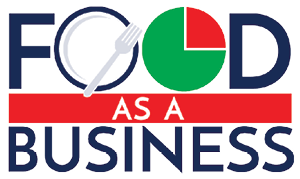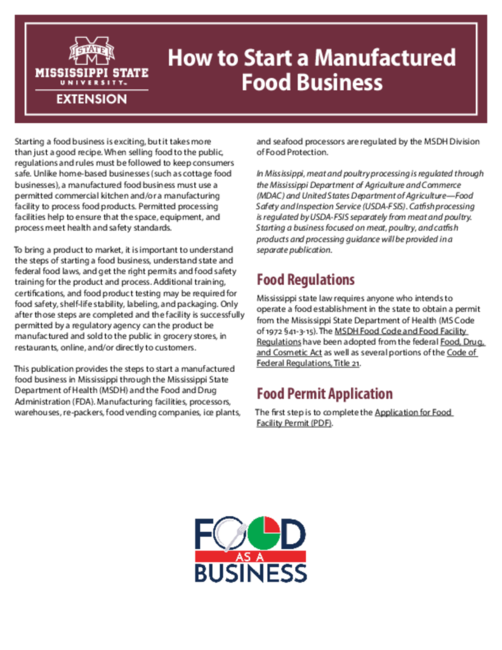P4141
How to Start a Manufactured Food Business

Starting a food business is exciting, but it takes more than just a good recipe. When selling food to the public, regulations and rules must be followed to keep consumers safe. Unlike home-based businesses (such as cottage food businesses), a manufactured food business must use a permitted commercial kitchen and/or a manufacturing facility to process food products. Permitted processing facilities help to ensure that the space, equipment, and process meet health and safety standards.
To bring a product to market, it is important to understand the steps of starting a food business, understand state and federal food laws, and get the right permits and food safety training for the product and process. Additional training, certifications, and food product testing may be required for food safety, shelf-life stability, labeling, and packaging. Only after those steps are completed and the facility is successfully permitted by a regulatory agency can the product be manufactured and sold to the public in grocery stores, in restaurants, online, and/or directly to customers.
This publication provides the steps to start a manufactured food business in Mississippi through the Mississippi State Department of Health (MSDH) and the Food and Drug Administration (FDA). Manufacturing facilities, processors, warehouses, re-packers, food vending companies, ice plants, and seafood processors are regulated by the MSDH Division of Food Protection.
In Mississippi, meat and poultry processing is regulated through the Mississippi Department of Agriculture and Commerce (MDAC) and United States Department of Agriculture—Food Safety and Inspection Service (USDA-FSIS). Catfish processing is regulated by USDA-FSIS separately from meat and poultry. Starting a business focused on meat, poultry, and catfish products and processing guidance will be provided in a separate publication.
Food Regulations
Mississippi state law requires anyone who intends to operate a food establishment in the state to obtain a permit from the Mississippi State Department of Health (MS Code of 1972 §41-3-15). The MSDH Food Code and Food Facility Regulations have been adopted from the federal Food, Drug, and Cosmetic Act as well as several portions of the Code of Federal Regulations, Title 21.
Food Permit Application
The first step is to complete the Application for Food Facility Permit (PDF).
Plan Review Application
To ensure the operation meets the basic regulatory requirements, an establishment Plan Review needs to be submitted to the MSDH for evaluation and approval, prior to manufacturing. The MSDH provides an outline of the steps for a Plan Review. It is important to keep in mind that the MSDH processes facility permits electronically. Request a Plan Review packet by emailing mfgfoods@msdh.ms.gov.
Manufacturers are required to submit the following unless otherwise advised by the regulatory authority:
- A floor and/or site plan.
- A list of food items processed and/or held in the food facility.
- Proofs of food product label(s) for approval.
- Food products must be labeled according to the FDA Food Labeling Guide.
- Note: It is not recommended to purchase labels until the labels are reviewed by the regulatory agency.
- Proof that the food packaging material(s) are food grade.
- A food safety plan. Food Safety Plan Builder (FSPB) is a tool designed to assist owners/operators of food facilities with the development of food safety plans that are specific to their facilities and meet the requirements of the Current Good Manufacturing Practices (cGMPs), Hazard Analysis, and Risk-Based Preventive Controls for Human Food regulation (21 CFR Part 117).
- Proof of implementation of Current Good Manufacturing Practices, which help ensure food safety. cGMP regulations address matters including appropriate personal hygiene practices, design and construction of a food plant, maintenance of plant grounds, plant equipment, sanitary operations, facility sanitation, and production and process controls during the production of food.
- Documentation of how the firm will monitor the eight keys of sanitation:
- Safety of water
- Condition and cleanliness of food contact surfaces
- Prevention of cross-contamination
- Maintenance of handwashing, hand sanitizing, and toilet facilities
- Protection from adulterants
- Labeling, storage, and use of toxic compounds
- Employee health conditions
- Exclusions of pests
- A written recall plan that addresses how adulterated products will be recalled from commerce. Here are two resources:
- A food defense and biosecurity plan that addresses how products will be protected from intentional contamination.
- Proof of FDA Food Facility Registration. Registering a facility is free and mandatory for all food processors as part of the Public Health Security and Bioterrorism Preparedness and Response Act of 2002 (the Bioterrorism Act).
- A list of where products will be distributed.
- Information on how the products will be transported securely.
Manufacturers may have to provide additional supporting documentation and food safety training certification depending on the product and process. This documentation may include the following:
- HACCP plan (Risk Category 3 or 4)
- Seafood HACCP certification
- Juice HACCP certification
- Better Process Control School certification
- FSPCA Preventive Controls for Human Food (PCQI) certification
- Approval of water source (if private). Contact the MSDH Bureau of Water Supply at (601) 576-7518.
- Approval of on-site wastewater system. Contact the MSDH Division of On-Site Wastewater to ensure that the system can accommodate the output from the operations: (601) 576-7150.
Submission, Payment, and Review
Complete and submit the Food Permit Application and Plan Review. The paperwork and supporting documentation can be mailed to the address on the Food Permit Application and Plan Review or emailed to mfgfoods@msdh.ms.gov.
To help expedite the permit and plan review process, put the facility name in the subject line of the email and on all documents submitted. It may take up to 48 hours to receive the acknowledgement of application receipt. Review of a completed application may take up to 30 days.
Upon receipt of the application, you will be prompted to pay a plan review fee. The plan review fee must be paid online before the plan review begins.
After the plan review has been approved, you will receive an invoice for the permit fee. Permits must be paid online before an inspection can take place.
The cost of an annual food permit is determined by the risk level assigned to the facility during plan review and will be evaluated yearly at the time of facility inspection. Reinspection also has a fee.
Summary
Starting a manufactured food business involves planning, patience, and a focus on safety, but it is possible if entrepreneurs take it step by step. By following food safety rules, using a permitted facility, and creating accurate labels, businesses can share products with more people. Good planning and hard work will help the business grow and give customers food they can trust and enjoy.
Resources
Association of Food and Drug Officials Seafood HACCP Alliance
Food Safety Preventive Controls Alliance (FSPCA)
Mississippi State Department of Health (MSDH)
- Application for Food Facility Permit (PDF)
- Food Permits and Fees – Obtaining a Food Permit
- Regulation Governing Manufacture and Sale of Food and Food Products (PDF)
- Starting a Manufactured Food Business
Mississippi State University Extension Service. Basic Labeling Requirements for Food Products Entering Commerce (P2920)
U.S. Code of Federal Regulations. Food and Drugs, Title 21
U.S. Food and Drug Administration
- Current Good Manufacturing Practices (cGMPs) for Food and Dietary Supplements
- Federal Food, Drug, and Cosmetic Act (FD&C Act)
- Food Safety Plan Builder
- Guidance for Industry: Food Labeling Guide
- Hazard Analysis Critical Control Point (HACCP)
- Industry Guidance for Recalls
- Recall Plan: Draft Guidance for Industry (PDF)
- Registration of Food Facilities and Other Submissions

This work is supported by the Extension Risk Management Education Program, project award no. 2023-70027-40446, from the U.S. Department of Agriculture’s National Institute of Food and Agriculture.
Any opinions, findings, conclusions, or recommendations expressed in this publication are those of the author(s) and should not be construed to represent any official USDA or U.S. Government determination or policy.
The information given here is for educational purposes only. References to commercial products, trade names, or suppliers are made with the understanding that no endorsement is implied and that no discrimination against other products or suppliers is intended.
Publication 4141 (POD-09-25)
By Courtney Crist, PhD, Associate Extension Professor, Biochemistry, Nutrition, and Health Promotion.
The Mississippi State University Extension Service is working to ensure all web content is accessible to all users. If you need assistance accessing any of our content, please email the webteam or call 662-325-2262.
